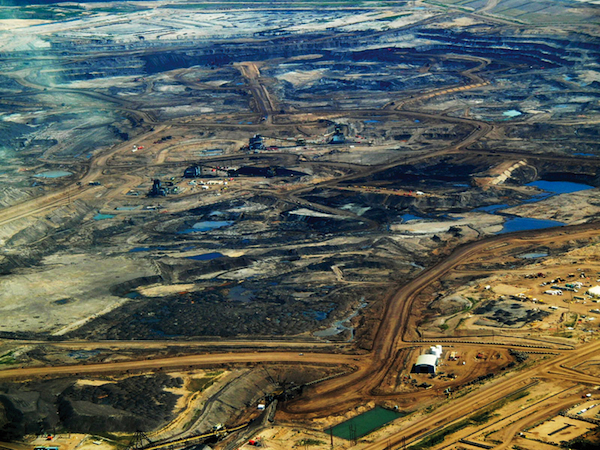The things we will do for a quick buck [6 January 2015 | Peter Boyer]
The pictures show rich wheat fields under big prairie skies giving way in the west to rolling foothills and the pine-clad, snow-topped Canadian Rockies. Alberta is surely a beautiful part of the planet.

Northern Alberta’s new-look landscape, courtesy of Big Oil and the Harper government. PHOTO Howl Arts Collective, Montreal
I’ve not been there, but I have a lifelong friend from whom I learned something of what it’s like to grow up there. Knowing him and having met his family, I feel a kind of affinity with the place.
There’s another connection. Brothers of my great-grandfather once panned for gold in Alberta’s far north, in the Peace River basin. There’s a Boyer River flowing into the Peace which I like to imagine got its name from them.
When the northern half of Alberta isn’t frozen it’s very wet, covered with rivers, lakes and swamps. And abundant vegetation, part of the great boreal forests which add up to the world’s biggest above-ground store of carbon. It has few humans but is rich in wildlife. Nature reigns supreme.
Or it did until the 1970s, when Middle East oil supply shocks prompted Big Oil to tackle bitumen deposits in northern Alberta’s Athabasca and Peace valleys. Mining activity stuttered along for decades, waiting for the price of oil to rise above break-even level. Now it’s full steam ahead.
More than two Tasmanias would fit into the area of the deposits, historically known as tar sands but officially given the more marketable name of “oil sands”. If the oil price stays high enough there are enough recoverable hydrocarbons there to make Canada the world’s biggest oil producer.
In 2006 Stephen Harper became prime minister of Canada. Just as his good friend Tony Abbott was later to champion coal as Australia’s gift to the world, Harper took on the cause of Alberta oil and declared Canada “an emerging energy superpower”.
Since then his government has massively promoted the oil sand deposits at home and abroad, and with bureaucratic obstacles removed global oil consortiums have joined the party. Over the next decade the area being mined is expected to treble in size.
Getting usable petroleum out of oil sand is neither easy nor cheap, which is why it took so long for extraction to reach today’s levels. It involves draining all wetlands and diverting rivers before removing trees, peat moss and soil above the deposits. All wildlife dies or is displaced.
Huge mechanical shovels scoop up tar-saturated sand in surface deposits and put it in trucks the size of a two-storey house. These take it to local plants where bitumen is extracted using very large quantities of water heated by a lot of natural gas to make steam.
But only about a fifth of deposits can be obtained in this way; the rest lie more than 100 metres underground. To extract this, yet more superheated steam is injected down into the deposit to make the bitumen fluid enough to be pumped to the surface.
All recovered bitumen must then be further liquefied before being pumped by pipeline from landlocked Alberta south into the United States and west through the Rockies to be shipped abroad. An already large pipeline network is being hugely augmented with ambitious new schemes.
Toxic water from the process is stored in vast tailings ponds, some just metres from rivers. If the rivers flowed south, millions in Edmonton and Calgary would use their water. But they go north, through small mainly-indigenous settlements and into the Arctic. Out of sight, out of mind.
A doctor who reported a sharp rise in cancer cases among people eating fish caught downstream from the mines was charged with causing “undue alarm”. The charges were dismissed. An Alberta Cancer Board report was inconclusive, but a university study found toxins in river water. Indigenous leader Allen Adam has recently called for a new assessment independent of both industry and government.
Carbon is lost to the atmosphere not only in removed trees and through heating, treating and transporting the crude. A 2012 University of Alberta study found that carbon emissions from just the surface peat removed for the mines then operating could top 45 million tonnes.
There may be mitigating circumstances. Some of the peat may be saved, and remediation may eventually allow something approaching a new forest to grow on mined land. But what has been lost can never be recovered, and much more will be lost in years to come.
Like mining for coal by destroying farms, forests and mountaintops, the huge environmental and human cost of exploiting the oil sands can never be justified by “economic benefit”. There’s something unhinged about this reckless adventure, and more than a whiff of megalomania.
“Ozymandias” comes to mind, Percy Shelley’s powerful sonnet about the remains of an ancient despot’s once-massive statue. The broken head reveals a “frown, and wrinkled lip, and sneer of cold command”. “Look on my works, ye Mighty, and despair!” is inscribed on the statue’s base.
The poem ends: “Nothing beside remains. Round the decay / Of that colossal wreck, boundless and bare / The lone and level sands stretch far away.”
